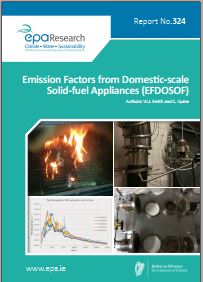Authors: W.J. Smith and C. Quinn
Summary: The Emission Factors from Domestic-scale Solid-fuel Appliances (EFDOSOF) study set out to establish representative, real-world emission factors (EFs) for the range of solid fuels used for residential combustion in Ireland. The improved EFs developed during this study will inform and improve Ireland’s response to the UNECE Convention on Long-range Transboundary Air Pollution and to the EU National Emission Ceilings Directive.

Watch the EFDOSOF project highlights video
In Ireland, particulate matter with a characteristic size of 2.5 microns or less (PM2.5) is the primary cause of premature death linked to air pollution; the 2019 air quality report from the European Environment Agency attributes over 90% of such deaths to this cause. Although the introduction of a smoky coal ban has significantly improved air quality and mortality rates in a number of Irish towns and cities, combustion of solid fuels in the residential sector remains the largest single contributor of these emissions and also contributes significantly to emissions of gaseous pollutants such as nitrogen oxides, carbon monoxide and sulfur oxides. Establishing representative EFs for the combustion of solid fuels is required to ensure robust national reporting of air pollutant emissions and to inform policies to reduce air pollution.
The EFs presented in this report were obtained using a domestic stove designed to current standards; EFs for open fires are likely to be higher and those for stoves designed to Ecodesign Directive standards are likely to be lower than those presented here. Particulate emissions were determined by passing a sample of raw flue gas through a heated (120°C) filter. PM data obtained using this “hot filter” technique are generally lower than those obtained using a dilution tunnel, particularly for fuels (such as wood and peat) containing a high proportion of volatiles. This report highlights that significant variations occur from test to test, and emissions from the ignition and start-up phases contribute significantly to total emissions. This makes the determination of representative EFs challenging, a challenge that was overcome by completing several hundred such tests to provide statistically robust EFs.
These results are unique in several respects: they represent emissions over the complete combustion cycle, from ignition through to extinction; they cover sod peat, peat briquettes, bituminous and smokeless coals, hardwood, softwood and firelighters; and they are statistically robust. The results reveal that emissions of PM2.5 were high, relative to other sources, for all fuels tested (10–100 times higher than for a modern diesel passenger car). PM2.5 emissions from sod peat were highest of all fuels tested. Firelighters, although accounting for only 3% of fuel mass, were found to contribute 15–40% of PM2.5 emissions for a typical test. These findings provide a firm basis on which to build policies to improve urban air quality and to reduce negative impacts of emissions of PM2.5 on human health.
This report concludes that the combustion of solid fuels in manually operated stoves and other domestic-scale appliances results in high levels of emissions of PM2.5. The adverse impact on local air quality will be greatest in urban areas and where the use of such appliances is concentrated. The combustion of sod peat in urban areas is especially undesirable.
The study highlighted that the moisture content of wood fuels has a significant bearing on both the emission intensity and the efficiency of the combustion process. This report recommends considering the regulation of fuel quality for commercially traded wood fuels.
Finally, this study has identified firelighters as a potentially significant, and previously unrecognised, source of particulate emissions. The report recommends that development and imposition of particulate matter emission standards for firelighters may be advisable.
https://www.epa.ie/media/epa-2020/publications/research/Thumbnail_324[1].jpg